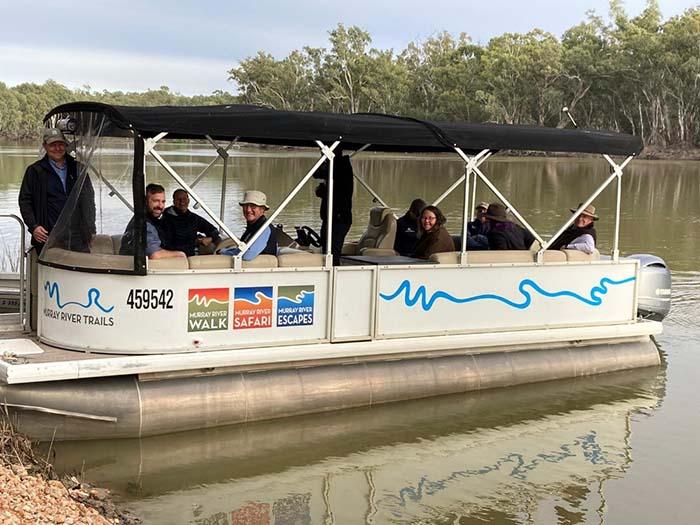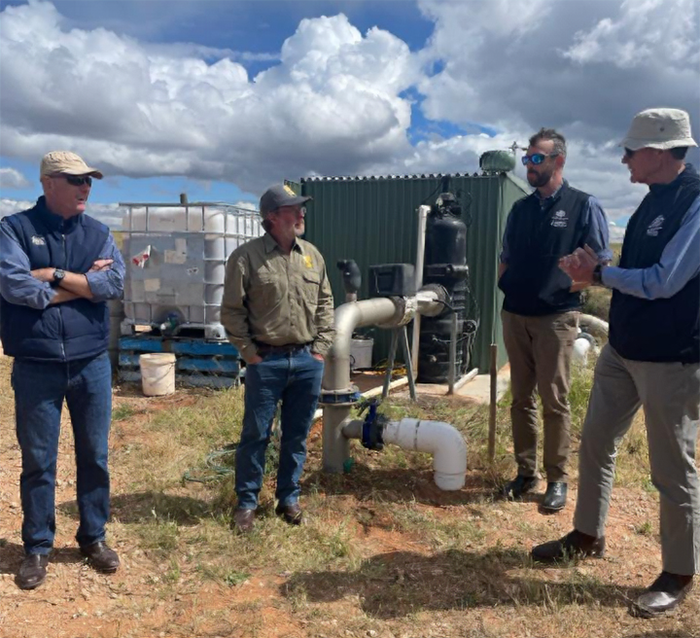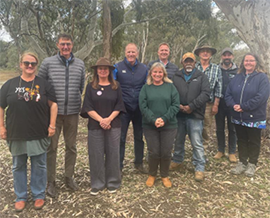The tour, which kicked off in South Australia’s Riverland and concluded across the border on the Loddon River in Northern Victoria, provided an opportunity for the MDBA to connect with basin communities to listen, learn, hear concerns, and build relationships.
Tuesday 3 October
The 4-day journey commenced at the Sugar Shack Environmental site near Swan Reach, which was alive and flourishing in the wake of earlier flooding. The delegation heard about the challenges in managing carp numbers and how drones have enabled mapping and plotting to improve wetland management.
Travelling upriver, the next stop on the tour was Katarapko, a 9500 ha wetland complex loved by locals for recreation and camping. Katarapko floodplain management site is a demonstration of the coexistence of nature and responsible land use, embodying the sustainable future we aspire to create to ensure rivers for generations.
At Katarapko, the group saw how beneficial the floodplain infrastructure has been for sustainable management of the surrounding ecosystem and heard how the site supports rich biodiversity while promoting a balanced and resilient environment. The site serves as an educational resource, allowing visitors to gain a deeper understanding of the intricate web of life and the importance of floodplain ecosystems.
Wednesday 4 October
After an overnight stay in Renmark, the team viewed the River Murray by boat on board an early morning river cruise. They spoke to local eco-tour operators Murray River Trails about how the Basin Plan provides security to communities and local businesses.
Murray River Trail tour guides are trained in the ecology and management of the region and speak about the Basin Plan and its importance as part of their Murray River experiences.
“The Murray doesn’t get the showcase it deserves. We need to make it a tourism icon,” Sir Angus said. “It feeds the soul to connect with nature...we need to keep it healthy.”

The next stop was Pike River to participate in a deep cultural experience hosted by Eric Cook of River Murray Mallee Aboriginal Corporation. Eric shared his personal connection to Country and educated the group on the archaeological history and powerful connection and use of the floodplains dating back some 40,000 years.
The insightful experience was a strong reminder of the history and cultural knowledge held by First Nations people.
The group then joined various stakeholders from Almondco Australia in Lyrup before heading off to a local date farm, Gurra Downs Date Company. Owner Dave Reilly spoke about the groundwater driven salinity issues around Gurra Lakes and pointed out the seepage from the cliffs. Despite facing challenges, including the impact of the 2022–23 River Murray Flood event, the farm continues to supply 90% of Australia's domestic dates and with the support of Commonwealth funding through the Commonwealth On-Farm Further Irrigation Efficiency Program (COFFIE) and Murray–Darling Basin Sustainable Rural Water Use and Infrastructure Program (SRWUIP), new infrastructure has been implemented to allow access to fresher water from the River Murray Channel.

Commonwealth and State funding has supported various producers in and across the Basin and as the tour continued further into the Riverland it was fantastic to see the uptake of initiatives such as the Murray–Darling Basin Water Efficiency Program.
Stopping off at Lloyd and Sons Citrus Farm, the contribution of this program was evident. While netting to prevent wind blemish on their fruit was a priority initially, the delegation heard additional benefits including a 25–30% water saving across the netted orchard and increased growth rates of the fruits. Additional improvements within the citrus crop also included the adoption of the Phytech plant-based monitoring system as part of the 450 water efficiency program.
Thursday 5 October
The day started with a stop at the Tree of Knowledge, a towering river red gum in Loxton valued by locals and tourists alike. The tree has recorded the height of floods in the region for decades.

Upstream at Loxton, the South Australian Department for Environment and Water hosted a tour of sites along the Loxton riverfront, showcasing how the implementation of the MDBA’s Constraints Management Strategy has improved infrastructure and enabled the community to adapt to the environmental benefits of future flooding and river management while reducing the negative impacts of infrastructure on the floodplain that is not fit for purpose.
Across the border at Ouyen Lake, the delegation was greeted by Grampians Wimmera Mallee Water and discussed the success of The Living Murray Indigenous Partnerships Project that has taken place over the years along with the construction of the Wimmera Mallee Pipeline.
Conversations revolved around the significant water savings that have been achieved by the pipeline and the socioeconomic benefits to communities along with the increased liveability as a direct result of the development of Ouyen Lake. The group also heard that quality and security of water in the area has increased liveability and enabled expansion and growth.
Travelling east, the next stop on the tour was Wood Wood, where the Friends of Vinifera shared their views on the importance of collaboration across Basin States to achieve outcomes. Further discussions were had about constraints, infrastructure and the importance of First Nations’ roles and access to Country.

They spoke about the poor health of the floodplain and its negative impacts on local bush tucker and bush medicine, as well as impacts on the mental health and wellbeing of local First Nations people.
“The knowledge and lived experience of First Nations people in the Basin is critical to improving water management,” Sir Angus said. “By listening to and learning from each other we can work together to improve the health of our river system for future generations.”
The Basin Plan has seen an important shift in the recognition of First Nations people’s values, and uses of water in the Basin. Community expectations and knowledge on these issues has progressed considerably over the last decade and there is much more to be done.
The Basin Plan Review will investigate opportunities to recognise and, where possible, support the outcomes desired by First Nations people. We’ll work with First Nations people to appropriately incorporate their knowledge into the evidence base we use and continue to improve our engagement with Basin communities.
Friday 6 October
The day began with conversations with Federal Member for Mallee, Dr Anne Webster MP sharing what had been heard along the listening journey before heading south to Lake Boga. Community perspectives on the Basin Plan were discussed and the importance of recreational water in regional areas was once again a passion point of attendees.
Discussions were facilitated by Goulburn Murray Water and Lake Boga and Districts Landcare Group. Attendees expressed their concerns relating to downstream developments and advised on the diverse opinions surrounding the Barmah Choke.
“What links everyone together is the desire for the ongoing health and sustainability for their much-loved part of the Murray–Darling Basin,” Sir Angus said. “That same vision is what drives me, and the work of the MDBA.”
Conversations flowed about flood management, environmental benefits of modernisation, the Number 9 pumpstation and the current 1A/9 pipeline project on the commute to Little Murray Weir and Third Reedy Lake towards Kerang.
Touring Third Reedy Lake it was great to hear from Goulburn–Murray Water about the infrastructure and channel management approach that has made it possible to mimic the wetting and drying of this important wetland Ramsar Site – regenerating native river red gum and black box. Stopping at Kerang, the last official stop of the tour, the group viewed the new 2/14/2 pipeline, which has converted an open channel to a pipeline which not only has improved delivery efficiency but also improved general safety and visual amenity within the urban setting.
We’re preparing for the 2026 Basin Plan Review
Opportunities like the listening tour better connect us to communities and stakeholders on the ground and help the MDBA appreciate the lived experience those who call the Basin home. After 10 years of Basin Plan implementation, we have heard that communities know what is working well and what could be improved or done differently.
We will work with others, test evidence with communities, and provide the opportunity for your lived experience to inform our recommendations as we plan for the 2026 Basin Plan Review.
All Australians benefit from a healthy Murray–Darling Basin. Its economic, environmental and cultural contribution to our country is immense. A range of opportunities will be available for all interested Australians to have their say. Keep an eye on Basin Plan Review for up-to-date information and opportunities to engage.